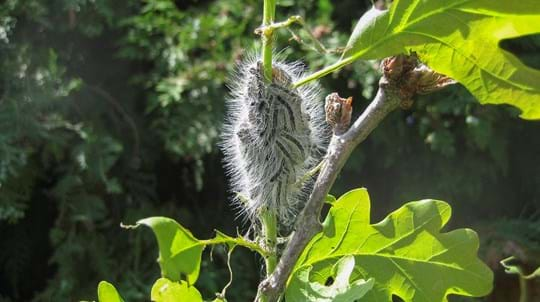
Pests and diseases
Oak Processionary Moth
A threat to both human and animal health.
Foresty Commission
Despite the COVID-19 pandemic, the control, survey, and research of Oak Processionary Moth (OPM) continued as all operational activity was regarded as essential but would be conducted in line with COVID-19 safe-working precautions. These essential activities were to help:
During 2020, Forestry Commission (FC) surveillance focused on the 2019 interception sites and assessing the success of the OPM spray programme. 136,185 trees were surveyed as part of the FC summer nest survey programme, of which 5,352 trees were found to be infested. Additionally, 4,129 infested trees were reported to the FC by other groups or individuals. The infested trees were from 1,079 different sites. 163 pheromone traps were deployed in the OPM Core Zone and across England (108 in Core Zone, 55 in wider environment). Several mobile app forms were developed to allow surveyors and contractors to record data in the field for operational and research purposes including:
This summer has also seen a high number of enquiries to both TreeAlert and the FC OPM team.
Date |
Tree alerts for OPM |
|---|---|
2017 |
62 |
2018 |
293 |
2019 |
334 |
2020 |
757 |
|
Date |
2017 |
2018 |
2019 |
2020 |
|---|---|---|---|---|
|
Tree alerts for OPM |
62 |
293 |
334 |
757 |
There are Protected Zone (PZ) survey plots in place across Britain to monitor for the presence of OPM in the wider environment. In the PZ, actions are taken when OPM is found to prevent establishment. During the summer, 85 sites (1,948 trees in total) were surveyed, working with our plant health colleagues and partners in the devolved administrations where necessary.
Some notable observations resulted from these surveys:
The 2020 trapping programme built upon previous research into the relationship between the numbers of male moths caught and the likelihood of a nearby OPM breeding population. A number of traps were also deployed in the wider environment for background sampling and to identify any areas that may need further investigation. However, over the summer we discovered that the pheromone lures provided by our supplier were defective and an alternative supplier needed to be found. No moths were found in the traps in the wider environment, but these results will be treated with some caution.
This year we received a total of 73 reports of OPM captures in light traps. These reports came in via social media streams, TreeAlert and through the OPM team. Most were in areas where we would expect to find OPM due to known populations. In addition, we received a few reports of moths being blown over from the continent. This is quite common and we would expect to find them along the South and East coast. This does not indicate that breeding populations of OPM have become established at those locations.
This year we worked alongside the Observatree citizen science project and developed a bespoke mobile working application to record OPM. This was introduced during the summer and has provided additional and valuable information to the OPM project. It is hoped that this will be used again next year to generate more data.
The surveillance of OPM across Britain utilises a variety of methods and information provided by many groups and individuals. As shown with the pheromone trapping, it is important not to rely on a single source of information and we are grateful to all professionals, groups, volunteers and individuals who continue to support us with this important work.